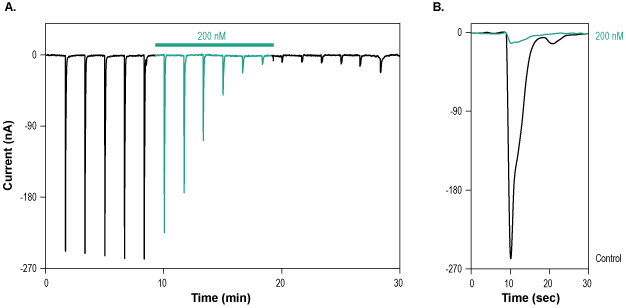Overview
- Reddy, N.L. et al. (1994) J. Med. Chem. 37, 260.
 Alomone Labs CNS-1102 inhibits NMDA receptor channels expressed in Xenopus oocytes.A. Time course of NR1/NR2A currents elicited by transient stimulations with 100 µM glutamate and 100 µM glycine every 100s, while membrane potential was held at -80 mV. Application of 200 nM CNS-1102 (#C-305) for 10 min (green) significantly inhibits current amplitude. B. Superimposed current traces from the recording shown in A upon application of control (black) and of 200 nM CNS-1102 (green).
Alomone Labs CNS-1102 inhibits NMDA receptor channels expressed in Xenopus oocytes.A. Time course of NR1/NR2A currents elicited by transient stimulations with 100 µM glutamate and 100 µM glycine every 100s, while membrane potential was held at -80 mV. Application of 200 nM CNS-1102 (#C-305) for 10 min (green) significantly inhibits current amplitude. B. Superimposed current traces from the recording shown in A upon application of control (black) and of 200 nM CNS-1102 (green).
- Schäbitz, W.R. et al. (2000) Stroke 31, 1709.
- Albers, G.W. et al. (2001) JAMA. 286, 2673.
- Black, S.A. et al. (2014) Front. Cell Dev. Biol. 2, 45.
CNS-1102 is a potent, non-competitive, and selective NMDA receptor (N-methyl-D-aspartate) antagonist. In animals, CNS-1102 reduces the volume of ischemic cerebral infarction and in humans it is being used as a potential agent for the treatment of acute ischemic stroke or neurotrauma stroke. It has the ability to protect white and gray matter from ischemic injury1,2.
NMDA receptors are heterotetrameric channels formed by the assembly of two obligatory GluN1 and two GluN2/GluN3 subunits. NMDAR plays an important role in a variety of cellular processes and brain functions such as synaptic plasticity, addiction and stroke. They also mediate physiological functions such as learning and memory formation, glutamate excitotoxicity and are involved in many neurodegenerative conditions including Alzheimer’s disease3.
CNS-1102 (#C-305) is a highly pure, synthetic, and biologically active compound.
Applications
Citations
- Amakhin, D.V. et al. (2018) Front. Cell. Neurosci. 12, 486.

